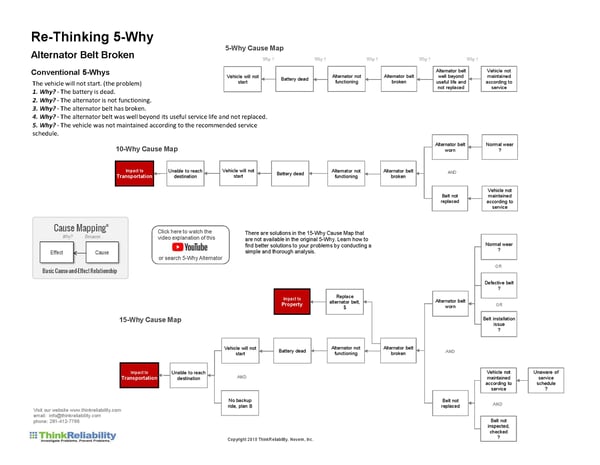What the Critics Don't Understand
Even though the 5Whys tool is well known, its application varies widely. There are devout 5Whys users who believe the fifth Why question yields the root cause of the problem, while others think 5Whys is useless and should never be used. These polarized views are both off the mark. Each is confusing how cause-and-effect applies to analyzing problems.
I’m going to address the criticisms listed on the 5Whys Wikipedia web page. It contains an explanation of 5Whys, an example 5Whys using a car alternator belt, the history of 5Whys, rules for applying it and then the criticisms. There are five criticisms listed as bullets. I have summarized them below. If you’d like to see the alternator belt example built into 5-Why, 10-Why, and 15-Why Cause Map™ diagrams watch the following video and download the PDF below it to follow along.

Summary of 5Whys Criticisms:
- Stopping at symptoms.
- Limited by the investigator's knowledge.
- Not asking the right Why questions.
- Not repeatable - Different people build different 5Whys.
- Tendency to isolate a single root cause
Here are each of the criticisms as listed on the Wikipedia page and my explanation of how each reveals the confusion about something as simple as cause-and-effect.
1. Tendency for investigators to stop at symptoms rather than going onto lower level causes
Premise of criticism: Asking five "why" questions may not be enough.
Correct. Organizations typically stop investigations too early, so having a predefined endpoint of five Why questions is not ideal. But asking five Why questions is a great way to start. It’s a valid question and it’s simple. Smaller problems may stay in the range of three to five or even seven Why questions, but bigger problems will require more detail - which is going to be more Why questions. There is no reason to restrict the analysis of your problems to just five causes. In Cause Mapping® root cause analysis, a 5-Why is just a phase of an investigation. It begins with a 1-Why, then goes through 5, then 6 and if needed it goes to 15, 25 or more depending on the issue. Keep it simple. Start with a few Why questions then expand as needed.
2. Inability to go beyond the investigator's current knowledge - cannot find causes that they do not already know
Premise of the criticism: The investigator’s knowledge is crucial to the investigation.
The belief that an investigation is limited by the knowledge of one person is not reality. An investigation needs to be a thorough explanation of why something happened, but those details are not limited to the investigator. Detail is provided by people who know. Experts on a topic will need to participate in the investigation to explain cause-and-effect. Investigating a blade failure on an aircraft engine, requires experts on blades and engines. If there are any unknowns during the investigation, additional details will need to be collected. This is a normal part of evidence collection – it’s an iterative process. This systematic, structured approach is what doctors, auto mechanics and technicians do every day.
3. Lack of support to help the investigator ask the right "why" questions
Premise of the criticism: Why questions are subjective.
There isn’t a technique to ask Why questions. There is an understanding of basic of cause-and-effect. Once people understand the basics of cause-and-effect, the misplaced emphasis on the questioning technique and the facilitator changes. The thorough explanation of an issue is a function of capturing accurate and complete cause-and-effect relationships, not a special approach to questions. Without an understanding of basic cause-and-effect it’s clear why people would use terms like the “right Why questions.” They believe there is a special way of determining why something happened. The focus should be on objective facts, not subjective questions. How and why a problem happened occurred before the investigator ever got involved.
4. Results are not repeatable - different people using 5 Whys come up with different causes for the same problem
Premise of the criticism: 5-Why is not scientific because it’s not repeatable.
When different people build different 5-Whys for the same problem some believe that is the evidence that 5-Whys is not scientific. That criticism reveals the level of confusion regarding the simple principle of cause-and-effect. It’s normal and expected for three different people to build three different 5-Why diagrams. As long as each 5-Why Cause Map diagram is accurate, they can be combined into one 10-Why Cause Map diagram with three different causal paths. The three 5-Why diagrams are subsets of the 10-Why. Each person can look at the 10-Why Cause Map diagram and say, “without the cause I pointed out, this incident would never have happened.” There is no contradiction in their statements. These are simple lessons of cause-and-effect that change the way detail is communicated. And as result, the way those organizations analyze, document, and prevent problems suffers. It is OK that different people build different 5-Why diagrams.
5. Tendency to isolate a single root cause, whereas each question could elicit many different root causes
Premise of the criticism: There may be more than one root cause.
This brings up a good question. What is a root cause? Most companies define a root cause as a special type of cause. Most people say that if the root cause is controlled the problem will be eliminated. And some groups may identify more than one root cause. An incident may have multiple root causes. This again seems like such a clean and consistent way to discuss problems. But there’s an issue with the logic. Incidents consist of multiple parts – 2, 5, 10, 15 or 30. To find the best solutions it’s important to break a problem down into parts. But how many parts? The premise of this criticism of 5Whys is that root causes are special. They are different than contributing factors somehow. How are they different?
That’s my question for you to leave in the comments section. Is there is difference between a root cause and a contributing factor? What are the differences? Can you provide an example of how they are different? Does your company spend time trying to differentiate between root causes and contributing factors?
Conclusion
5-Why Cause Mapping is fundamentally based on cause-and-effect. A 5-Why diagram is not a complete method, it’s simply a phase of an investigation. On big issues you’ll quickly pass through a 5-Why on your way from 4 to 6 and more. You’ll notice that groups who are anti-cause-and-effect will also be anti-5-Why. There is a big opportunity. Management wants problems solved. Any move in the direction of a systematic, clearer and simpler is good. You should challenge anything that appears to be alternative to cause-and-effect. Check your assumptions and, most of all, field test this material. Watch some of our videos, read our blogs and view some of our examples. We’re pretty transparent. Test it on the problems you’re working. Get your own evidence.
Don’t hesitate to contact me if you have questions or call our office. We’ll be glad to help and engage in a discussion. Learn to make complex problems easier to understand. You might be making it too difficult, taking too long and spending more than you need to. We also offer 5-Why Training that focuses on this important piece of investigating incidents. Thank you for going through this and send us some feedback.











